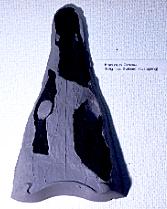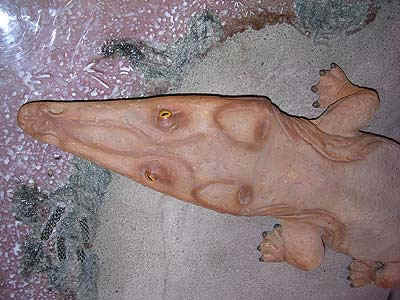 Trematosauridae: Aphaneramma, Erythrobatrachus, Lyrocephaliscus, Mahavisaurus, Microposaurus, Platystega, Stoschiosaurus, Tertrema, Tertremoides, Trematosaurus, Trematosuchus, Wantzosaurus. Defined [S02] as Wantzosaurus + Lyrocephaliscus.
Trematosauridae: Aphaneramma, Erythrobatrachus, Lyrocephaliscus, Mahavisaurus, Microposaurus, Platystega, Stoschiosaurus, Tertrema, Tertremoides, Trematosaurus, Trematosuchus, Wantzosaurus. Defined [S02] as Wantzosaurus + Lyrocephaliscus.| Temnospondyli | ||
| The Vertebrates | Trematosauridae |
| Vertebrates Home | Vertebrate | Vertebrate |
|
Abbreviated Dendrogram
Tetrapoda
├─┬─Lepospondyli
│ └─Reptiliomorpha
│
└─Temnospondyli
├─Edopoidea
└─┬─Dvinosauria
└─┬─Euskelia
│ ╞═Dissorophoidea
│ │ └─Lissamphibia
│ └─Eryopoidea
└─Stereospondyli
├─Rhinesuchidae
└─┬─Lydekkerinidae
├─┬─Plagiosauroidea
│ └─┬─Rhytidosteidae
│ └─Brachyopoidea
└─┬─Capitosauria
└─Trematosauria
├─Trematosauroidea
│ ├─Thoosuchinae
│ └─┬─Yarengia
│ └─Trematosauridae
│ ├─Luzocephalidae
│ └─┬─Angusaurus
│ └─Trematosaurus
└─Metoposauroidea
|
Contents
Index |

Yarengia: Shishkin 1960. Y. perplexa Shishkin 1960.
Range: Early Triassic (Early Olneckian) of Russia (Archangel'sk).
Phylogeny: Trematosauroidea:: Trematosauridae + *.
Characters: exoccipital with reduced subotic process and elongated base [S+00]; $ parasphenoid body elongated, constricted (?) in the midline and indented on rear margin [D01]; parasphenoid plate ornamented [S+00]; pterygoid - parasphenoid suture elongate [D01] and underlies tympanic cavity [S+00]; parasphenoid crista muscularis curved in a unique fashion [D01]; "ornament on pterygoid predominates over shagreen" [S+00]; anterior palatal vacuities fused [S+00]; interchoanal tooth rows meet at acute angle [S+00].
Note: [1] known from an isolated basicranium. [2] Damiani (2001: 441) lists several other characters of unreasonable obscurity. He states that Yarengia is a mastodonsauroid (= capitosaurian) based on "a well-developed crista muscularis of the parasphenoid which presumably would have been confluent in the midline, and the presence of a crista obliqua of the pterygoid." The prominent crista muscularis is a character shared with the trematosauroids. The "confluence" character is found in other Mesozoic temnospondyls (Damiani, 2001: 454) and is thus probably a synapomorphy of a clade more inclusive than Mastodonsauroidea. While absent in Thoosuchus and Angusaurus, the state of this character is not known in Trematosaurus. The oblique ridge of the pterygoid is a character which, as Damiani notes, is also present in some trematosaurids (2001: 456). Even more significantly, Yarengia has an elongated pterygoid-parasphenoid suture, a synapomorphy of the Trematosauridae. Accordingly, pending more complete specimens, Yarengia is treated as a trematosauroid, as Shishkin originally proposed.
References: Damiani (2001) [D01]; Shishkin et al. (2000) [S+00]. ATW020720.
 Trematosauridae: Aphaneramma, Erythrobatrachus, Lyrocephaliscus, Mahavisaurus, Microposaurus, Platystega, Stoschiosaurus, Tertrema, Tertremoides, Trematosaurus, Trematosuchus, Wantzosaurus. Defined [S02] as Wantzosaurus + Lyrocephaliscus.
Trematosauridae: Aphaneramma, Erythrobatrachus, Lyrocephaliscus, Mahavisaurus, Microposaurus, Platystega, Stoschiosaurus, Tertrema, Tertremoides, Trematosaurus, Trematosuchus, Wantzosaurus. Defined [S02] as Wantzosaurus + Lyrocephaliscus.
Early Triassic (Olneckian) [D01] to Late Triassic [S02] of Australia, Europe (Spitsbergen), South Asia (Pakistan) & Madagascar [S02].
Trematosauroidea:: Yarengia + *: Luzocephalidae + (Angusaurus + Trematosaurus).
Characters: orbits broadly separated [S+00]; strong postorbital extension of skull table [S+00]; pineal foramen in posterior 1/2 of orbit - occiput distance [S+00]; squamosal posterior margin straight or concave [YW00] [1]; $ otic notch reduced to an embayment [D01]; occiput deep [S+00]; $ occipital condyles level with or posterior to quadrate condyles [D01]; parasphenoid plate elongate [S+00]; parasphenoid without crista muscularis [S+00]; parasphenoid plate extending posteriorly to cover the pedicel of exoccipital condyles (in ventral view) [S02]; parasphenoid, cultriform process laterally compressed and knife-edged [S+00] [S02$]; $ suture between pterygoid and parasphenoid elongated antero-posteriorly [D01]; pterygoid usually does not contact palatine [S+00]; pterygoid, ascending ramus, does not contact squamosal [S02]; anterior palatal vacuities well-separated [S+00]; retroarticular process elongate [S+00]; elongate posterior Meckelian foramen [S+00]; interchoanal tooth rows reduced or absent [S+00].
 Image: right) Tertrema,
© 1999, Palaeontological Museum, University of Oslo, Norway, courtesy of Dr. Hans Arne Nakrem.
Image: right) Tertrema,
© 1999, Palaeontological Museum, University of Oslo, Norway, courtesy of Dr. Hans Arne Nakrem.
Notes: [1] In Yates & Warren's (2000) study, this is the only character separating Thoosuchus from the Trematosauridae. See also related comments set out as a note under Thoosuchus.
Links: Abstracts for PaleoBios 14(1-4); amphibians; Trematosauroidea
Luzocephalidae: Luzocephalus.
Trematosauridae: (Angusaurus + Trematosaurus) + *. [S02]
Pterygoid unornamented and without denticles; ascending ramus of pterygoid does not contact squamosal (palatoquadrate fissure); main body of pterygoid broadly contacts lateral margins of parasphenoid; ectopterygoid with at least 3 rows of teeth, but tusks absent; vomeral fangs joined by transverse tooth row; posteroventral parasphenoid without rimmed depressions; parasphenoid denticles extend transversely onto ectopterygoid; palatine with elongate posteromedial process and >8 teeth; medial margin of choana with tooth row; prefrontals postfrontals articulate; maxilla - quadratojugal contact reduced or absent; orbits located about half-way along skull; orbits widely spaced; postorbital skull length 70-90% of width; straight or concave margin of squamosal in dorsal view; squamosal & tabular articulate on skull roof; otic notch wide, shallow embayment; extensive sensory sulci on skull; skull ornamentation of small pits enclosed by ridges.
Note: [1] Could well be a Lydekkerinid. [S+00] [2] The monophyly of this taxon seems to be in doubt. Several species of Luzocephalus have been referred to other families.
Shishkin et al. (2000) [S+00]; Steyer 2002) [S02]; Yates & Warren (2000).
ATW030905.
 Angusaurus: Getmanov 1989. A. dentatus Getmanov 1989, A. succedaneus Getmanov 1989, A. tsylmensis Novikov 1990 (?= Trematosaurus [S02]), A. weidenbaumi (= Trematosaurus w. = Thoosuchus w.) Kuzmin 1935.
Angusaurus: Getmanov 1989. A. dentatus Getmanov 1989, A. succedaneus Getmanov 1989, A. tsylmensis Novikov 1990 (?= Trematosaurus [S02]), A. weidenbaumi (= Trematosaurus w. = Thoosuchus w.) Kuzmin 1935.
Range: Early Triassic of Russia.
Phylogeny: Trematosauridae:: Trematosaurus + *.
Characters: skull up to 20 cm [S+00]; pineal foramen in middle of orbit - occiput distance [S+00]; quadratojugal does not participate in jaw condyle [D01]; elongate retroarticular process [S+00]; surangular medial process well-developed [S+00]; interchoanal tooth row strongly reduced [S+00].
Image: from Shishkin et al. (2000).
References: Damiani (2001) [D01]; Shishkin et al. (2000) [S+00]; Steyer (2002) [S02]. ATW020905.
 Trematosaurus: T. brauni Burmeister, 1849; T. madagascariensis Lehman, 1966 (possibly a juvenile of T. brauni [S02]); T. sobeyi ??, 1915. T. kannemeyeri is a junior synonym of Aphaneramma rostratum [S02].
Trematosaurus: T. brauni Burmeister, 1849; T. madagascariensis Lehman, 1966 (possibly a juvenile of T. brauni [S02]); T. sobeyi ??, 1915. T. kannemeyeri is a junior synonym of Aphaneramma rostratum [S02].
Range: Early Triassic (cosmopolitan)
Phylogeny: Trematosauridae:: Angusaurus + *.
Characters: skull triangular [S02]; prenarial region short [S02]; quadratojugal participates in jaw condyle (derived) [D01].
Image: from Palherp - Treffen der deutschsprachigen Paläoherpetologen
References: Damiani (2001) [D01]; Steyer (2002) [S02]. ATW030911.
checked ATW060327